Debido a la actual sequía en el corazón de la selva amazónica, en el lecho de un río han resurgido enigmáticos grabados antiguos que datan de entre 1.000 y 2.000 años de antigüedad. Este descubrimiento marca sólo la segunda vez que se presencia este notable fenómeno.

Ubicadas donde se encuentran el río Negro y el río Amazonas, en las afueras de Manaos, Brasil, las raras tallas, que datan de entre 1.000 y 2.000 años de antigüedad, representan agua, animales y pequeños rostros humanos. Los arqueólogos están tan impresionados con esto porque el grupo de rostros humanos solo ha sido revelado una vez antes, en una sequía regional de 2010.
Los grabados antiguos como estos normalmente se pierden bajo el agua para siempre. Sin embargo, una sequía reciente ha llevado los niveles de agua a un mínimo histórico en más de un siglo. Conocidas como “Caretas”, la pregunta clave que ahora enfrentan los investigadores en el Amazonas es: ¿quién esculpió estos petroglifos y qué significan?

Caritas con grandes historias
Además de animales tallados y representaciones simbólicas de agua, las cabezas humanas ligeramente cuadradas presentan bocas, pero sólo a algunas se les dio nariz. En un artículo en The Guardian sobre el momento en que se descubrieron los rostros por primera vez, Eduardo Neves, presidente de la Sociedad Brasileña de Arqueología, “las tallas indican un lugar de ocupación”.
Jaime Oliveira of the Brazilian Institute of Historical Heritage (Iphan) added in comment to the resurfacing of these petroglyphs, that the ancient Amazonians also endured periods of drought, “more severe than what we are experiencing now.” It can be concluded, that to have created these engravings, the river was dry, or it might not even have existed. And if this prize find of carved animals and humans wasn’t enough, according to a report in VOA , if the drought continues, the site archaeologists believe further carvings will be revealed along the river bed.

What Do the Carvings Mean?
This set of engravings depicting water, animals and human faces was first revealed back in 2010, when a drought revealed them for just one day. Crafted with axes made from chipped stone, Olivera described the group of petroglyphs as “complex graphic art.” Furthermore, the archaeologist said these little human figures “convey emotions, both happiness and sadness.”
Therefore, when interpreted correctly, the carvings will “reveal important insights into the societies that lived in this place.” And because the faces depict different emotions, they also represent ‘states of mind.’ This fact enables archaeologists to speculate what people celebrated and suffered during that period.

The faces are often of square appearance, like this one. (Valter Calheiros)
Racing Against Encroaching Tides
Currently, the discovery site is protected by the state, and until now archaeologists haven’t been permitted access to the area. Officials from the Geological Survey of Brazil have warned that the Rio Negro will probably rise again in November. So, the race is on to document the petroglyphs before they return to the depths of the river.
While this Amazonian discovery is remarkable, it comes under the shadow of the 2016 discovery of a 13 km (8 mile) long ᵴtriƥ of ancient rock discovered in the Amazon rainforest. This wild display of hunters interacting with Ice Age megafauna was published in the journal “Philosophical Transactions of the Royal Society B,” and the site has since been dubbed “the Sistine Chapel of the ancients.”

Deriving Human Emotions From Ancient Rock Arts
Located at Serranía La Lindosa, in modern-day Colombia, this expansive mural features tens of thousands of paintings and carvings. In a 2016 Ancient Origins article about this discovery we presented the discovery team claims that some of the art depicts “Ice Age megafauna including giant sloths, mastodons, camelids, horses and three-toed ungulates with trunks,” to name but a few.
Donde se unen el descubrimiento de la “Capilla Sixtina de los antiguos” y las “pequeñas caras” identificadas más recientemente es en sus representaciones de las emociones humanas y, por tanto, de los estados mentales. Mientras que algunas de las caritas sonríen ante el reciente descubrimiento, algunas de las personas en la “Capilla Sixtina” claramente están celebrando una cacería. Por el contrario, mientras algunas de las caritas están tristes, algunos de los cazadores del mural de la Capilla Sixtina están siendo perseguidos por depredadores.
Sólo el tiempo lo dirá, pero es probable que las caritas estén relacionadas con los tipos de animales representados a su alrededor, con las caras felices representadas alrededor de animales de presa y las tristes quizás cerca de depredadores.



